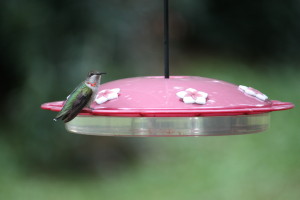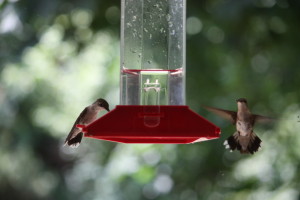Ruby-throated Hummingbirds,
Our Wee Feathered Friends
by Chris O’Connor
 Some weeks ago, I was lucky enough to witness a male ruby-throated hummingbird performing a “shuttle flight” right outside of my window, which is one courtship display. The male flies in a horizontal figure eight, like the symbol for infinity, to charm a breeding-age female hummingbird.
Some weeks ago, I was lucky enough to witness a male ruby-throated hummingbird performing a “shuttle flight” right outside of my window, which is one courtship display. The male flies in a horizontal figure eight, like the symbol for infinity, to charm a breeding-age female hummingbird.
One year I was late putting up the feeders. Some motion outside the kitchen window caught my eye. It was a male hummer, hovering as if to say, “Where’s the feeder?” which may evidence a hummingbird’s memory of its feeding grounds from the previous year. Ever after, I’ve had feeders up in early April for migrants passing through or for the returning birds.
Male ruby-throated hummingbirds return first from their wintering grounds to establish their territory and stake out their potential breeding grounds. Over the years, I’ve planted perennial plants so that hummingbirds will have some nectar-producing plants if I’m unable to fill the feeders.
One can always do more to help augment the survival of the ruby-throats—which are wonderful pollinators—as well as their mates and young, so I delved a bit deeper into their lives, which led me to learn about some constant threats to their survival.
Predators are a greater concern for hummingbirds than I imagined. Like many others, I have long thought that because of their speed and maneuverability on the wing, they were typically safer than many other birds. However, this is not the case.
Crows, blue jays, and hawks will kill them. Arboreal snakes will kill them. Fish such as the largemouth bass will snag them when the tiny birds fly low over water.
Creatures that my family recently evicted and relocated from our backyard for the clear and present danger they pose to the hummingbirds were bullfrogs, lizards, and dragonflies. Our backyard pond was drained and removed, and the vacant pond’s hole almost fully backfilled.
Ants will munch hummingbird eggs, but large insects like the praying mantis are known to lurk near feeders and flowers and ambush hummingbirds while they feed. Mantids are considered a beneficial insect, so if one is found lying in wait at a feeder or in a flower garden, wear gloves and relocate it.
A risk/reward problem for hummingbirds is that they use bits of sticky spider webs to construct their nests. Common garden spiders, such as the black and yellow orb weavers, can easily prey on a hummingbird that struggles in its web when it’s merely striving to find nest material.
Naturally occurring, passive threats are plentiful as well. Cockleburs and thistle can be problematic by trapping hummingbirds. And when hummingbirds go to sticky tree sap at a yellow-bellied sapsucker bird’s “well,” ostensibly for the bugs drawn there or the sap itself (which supplies nutrients, including amino acids), they can find themselves inextricably stuck there.
Man-made threats to hummingbirds are somewhat under our control. As with all living things, habitat loss is a concern. Use of pesticides and insecticides can greatly lessen or eradicate tiny insects that the hummingbirds need for protein.
One problem that’s repeated every season is a hummingbird flying through a door that was left ajar. I’ve had hummingbirds fluttering around on our screened front porch, which is a dual hazard, lest the bird in a frantic attempt to escape gets its bill stuck in the screen. If left undiscovered, a hummingbird may sustain considerable damage to its bill and/or quickly starve to death. Window screens carry the same threat for a bird that has such a miniscule bill.
All birds suffer huge losses from collisions with windows, and hummingbirds are no exception. Some ways to lessen mortality is to affix decals to the glass or draw curtains or shades.
Many experts also advise keeping garage doors closed, obviously making sure no hummingbirds are in there beforehand.
For those that choose to increase the ruby-throats plant nectar diet via nectar feeders should consider it a responsibility not to be taken lightly. Spoiled nectar that is cloudy, fermented, contaminated, or an incorrect recipe can and will kill the gorgeous, iridescent flying creatures.
The only safe sweetener that mimics natural plant nectar to fill hummingbird feeders is pure granulated sugar. The typical recipe, and the one to which I adhere, is one cup fluoride-free water (boiled) to one-quarter cup sugar or a ratio of 4:1—four parts water to one part granulated sugar.
I make sufficient solution to fill all feeders and store the remainder for up to a week in the refrigerator. I do not use commercially prepared hummingbird food or anything with red dye. Red dye is unnecessary as a means to attract hummingbirds, for most feeders sport some red coloring in their construction. Many believe red dye is extremely harmful to hummingbirds.
I clean/re-fill feeders every three days. In extremely hot weather, I offer the birds fresh sugar solution daily. Cleaning the feeders (with careful attention to the feeding ports) is an important step that’s much simplified by changing from the typical feeders commonly available at many stores to the top-lidded flat feeders.
Cleaning the widely-marketed feeders proved difficult getting at all the nooks and crannies. I now use the flat dish-style feeders (size of a salad plate), with an eight-or-more ounce capacity, to even smaller feeders that hold a mere four ounces of sugar water.
Soon, the flowers and feeders will be teeming with adult females, when their offspring fledge and leave the nest. It is said that the young outweigh their mothers when they no longer need care. The only way I can immediately tell the young from the adult birds is the length of their bills, and the compact and plump wee birdies that visit the feeders.
So it’s time to trot out my back-up feeders for the return of the thin, weary mother hummingbirds…and their surviving offspring.

Ruby-throated Hummingbirds

